 |
||
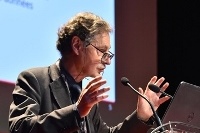 |
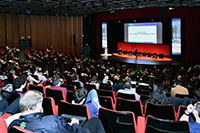 |
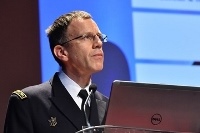 |
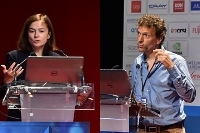 |
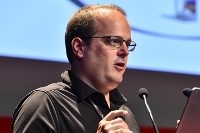 |
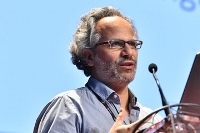 |
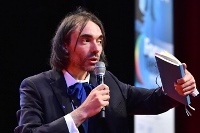 |
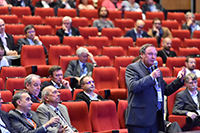 |
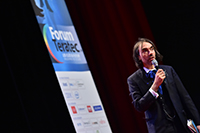 |
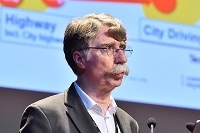 |
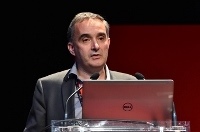 |
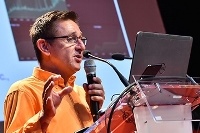 |
 |
 |
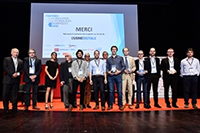 |
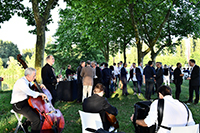 |
 |
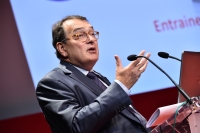 |
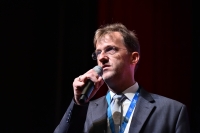 |
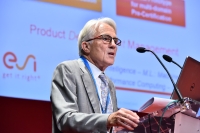 |
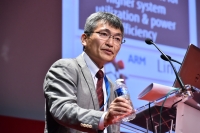 |
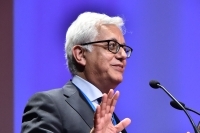 |
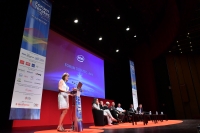 |
 |
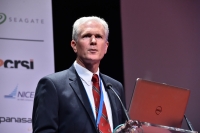 |
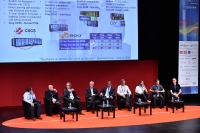 |
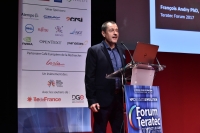 |
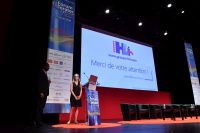 |
 |
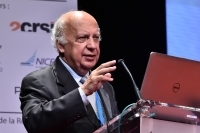 |
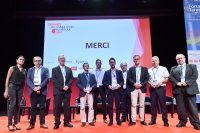 |
Home > TERATEC FORUM > Program
TERATEC 2018 Forum
Plenary sessions
Tuesday, June 19, 2018
Technological challenges and diversification of big data and simulation applications
The plenary sessions on first day provided a substantial overview of User needs from all industrial sectors, as well as current state-of-the-art of Suppliers and Research.
In his introduction, Christian Saguez, President of Teratec recalled the challenges that all economic sectors will have to face in order to achieve their digital transition processing very large volumes of data (IoT, networks, Big Data...), meeting very strong growth in computing power (CPU, GPU, FPGA, QPU...), developing algorithms adapted to parallelism (Deep Learning and IA...) as well as accessibility (Cloud, Blockchain...). He also insisted on the need for a continuous R&D effort, uniting Research and Industry, and bringing players together within major national and European programs, in a collaborative approach to master co-design of technologies and applications.
He then recalled the major European initiatives and programs underway where Teratec is participating (CESIMat; SiMSEO; DataPoc; EuroHPC; Horizon 2020; ITEA; ETP4HPC; IPCEI) insisting on efforts made by Teratec to help SMEs and ETI in particular for them to take step to the digital transition. "We are also launching a number of sectoral initiatives in: Autonomous Systems; Materials and their Uses; 3D Printing; HPC/HPDA in Pre-Projects; Health and Personalized Medicine; Natural Resources.”
He also announced the forthcoming opening of a Quantum Computing Competence Centre on the Teratec Campus in Bruyères-le-Châtel (91). "It will bring together a number of industrial users (CEA; Dassault-Aviation; EDF; IFP-EN; Total), technology providers (Atos) and research centers (CERFACS; the Paris Center for Quantum Computing - PCQC; the University of Reims) to rapidly build up skills and develop appropriate know-how. This competence center will be equipped with a quantum calculator simulator installed in the Computing, Research and Technology Centre (CCRT) located at the Teratec Campus.
Another important announcement is a collaboration agreement with Genopole to facilitate the processing of the very large volumes of digital data needed for genomics, personalized medicine and biotechnology research.
The Ecole Polytechnique which hosted the event is tackling such of these challenges. This was explained by François Bouchet, Director General of the school. Hence, he highlighted the importance of high-performance computing, combining mathematics and computer science, two strong points of the school, developed in curriculum programs, but also in the fundamental research that is conducted at X. He also announced the creation of a mesocentre of computing.
Isabelle Ryl, Deputy Director General for Industrial Transfers and Partnerships, and Bruno Raffin, Research Director at INRIA, recalled the role of the national institute in computer research and technology transfers towards user companies, as well as actions and research projects in more specific fields of Digital Simulation, HPC and Cloud (CS2@Exa; FRATRES; HAC-SPeCiS; DISCOVERY; HPC-BIG Data; ELCI; Grid'5000; SILECS; EoCoe; JLESC...). They particularly insisted on the inevitable convergence taking place between HPC and IA/Big Data and dedicated research underway at INRIA.
Closer to hardware equipment, Eric Van Hensbergen, Fellow & Senior Director of HPC de arm, presented the role of his company in the development of processors and architectures adapted to HPC needs such as the Cavium Thunder X1 and X2, with noticeable participation in the Montblanc project, or its presence at the heart of the OpenHPC and Linaro HPC-SIG.
Enhanced Artificial Intelligence through human intelligence
Highly appreciated, the presentation of Nicolas Vayatis, director of the CMLA and the Master MVA of the ENS Paris-Saclay, insisted on how human intelligence is designed to expand artificial intelligence. He drew an interesting parallel between B2C applications, widely used for digital marketing through the Internet, and B2B industrial applications. "The latter are generally very specific, representing quite high learning cost because of much required call on specialists’ expertise. Therefore, efforts are made to reduce such cost by replicating experiments. The challenge is to transfer all the knowledge or some parts related to different data and processes. It is therefore necessary to develop robust learning methods that sustain domain changes. The ideal is to calibrate methods with zero data. Another important point is to develop processing chains capable of adapting to the constant change in industrial data according to new products and production processes. These chains must also be able to use simulation data and combine them with real life data.”
Of course, the human factor should not be neglected in the development of these industrial AI applications. "We must not forget that these learning projects are computer projects with well-known pitfalls. Therefore, we must entrust them to IT specialists to avoid industrial disasters, while integrating experts in the field, close to the source of data, and take into account all information and remarks they will collect.”
Among the different learning methods, particularly well adapted to industrial contexts where transferring know-how of new problems on new systems is inevitable, Nicolas Vayatis believes that supervised and learning transfer will explode in the years to come. However, he believes that unsupervised and reinforced learning will remain marginal in the short term.
No Science without HPC
Finally, Cédric Villani, 2010 Fields Medal, Member of Parliament for the 5th Essonne constituency, First Vice-President of OPECST (Office parlementaire d'évaluation des choix scientifiques et technologiques) and coordinator of the parliamentary report ''Donner un sens à l'intelligence artificielle'', closed the morning by stressing that: "Science, and in particular AI, can no longer develop today without a considerable increase in the amount of computing needed, in order to support the development of intuition in most creative approaches or to avoid getting lost in absurdities.”
Going mobile with the automotive industry
The afternoon resumed with a presentation by Rémi Bastien, Renault's VP Prospective Automotive, who introduced us to the major challenges facing mobility players, particularly those involved in the automobile sector with the electric vehicle; the connected vehicle; the autonomous vehicle. "This trend has become of utmost importance for traditional car manufacturers who will have to face arrivals of new players such as Tesla, but also Google or Apple. This will change the way we see the automobile to become increasingly considered as a mobility service and no longer as a good, quite integral part of energy networks and resources pool, for example storing unconsumed energies even though they are produced.”
For the autonomous vehicle, technology will be important in terms of sensors, situation recognition through AI, decision support and steering actuators managing the accelerator, brake and steering. Technologies will have to become redundant to face possible failures of any part of the system. But the key to success will be public acceptance and confidence in systems safety. This requires experimentation to measure the reliability of such autonomous systems. "While the average number of road deaths in industrialized countries today sets at 1 in 1 million driving hours on roads and 1 in 10 million driving hours on motorways, car manufacturers have set their target to 1 in 100 million driving hours for the autonomous vehicle". It will therefore be much safer.”
The connected vehicle will be both a very large producer and a very large consumer of digital data, particularly as part of the ongoing dialogue it will establish with infrastructures and other vehicles to optimize traffic safety. "This means that in the medium term the vehicle will become a system of systems, with which software will represent more than half of the value. This is why digital simulation and HPC will be essential because, as Toyota has announced, physically validating one type of autonomous vehicle will require more than 15 billion km of tests.”
Europe mobilizing
Not so easy to describe the various European programs launched around HPC over the last decade. This is why Jean-Philippe Nominé, from the CEA's Strategic Analysis Department, delivered an overview of these developments to date. From Prace in 2010 to EuroHPC today, via ETP4HPC in 2012, the Rome Declaration of March 2017 truly reinforced European Commission’s strong renewed involvement from 2016.
"Today the Commission is launching the Digital Europe program, which will receive 9.2 billion€ funding over the period 2021-2027. It shows a real political will confirming the importance of these subjects. This first true European digital program will definitely help develop supercomputers, their components and software up to 2.7 B€, along with 2.5 B€ for Artificial Intelligence, 2 B€ for cyber-security, 700 M€ for training, adding 1.3 B€ to support the digital transition of administrations and companies.”
Easing Big Data processing
Denis Caromel, president and founder of ActiveEon, an INRIA spin-off, showed how its Workflows & Scheduler Suite run on HPC being linked to hybrid Cloud, allows very flexible processing of very large volumes of data across multiple economic sectors.
He showed how to create and validate a network of 20,000 Azure cores in less than 15 minutes, for as varied customers as CNES for satellite image analysis, Legal & General for financial risk analysis, Komatsu for the management of mining equipment via IoT, or the British Ministry of Interior for issuing visas and reducing crime, INRA in biotechnologies, and CEA-List for non-destructive evaluation of dedicated parts to the nuclear, oil and aerospace industries. "In addition to the processing level of performance, this type of solution also makes it possible to adjust the number of cores required for any given application quite highly appreciated by our customers' financial managers.”
Digital at the heart of naval systems
Often forgotten, the shipbuilding sector is a major user of Big Data, HPC and AI as well. This is what Eric Papin, Naval Group's technical, innovation and technological expertise director showed us. He explained how far digital technologies reach the heart of both military surface and submarine vessels, as well as associated means of production within shipyards through the "Digital Twin" approach.
"The complexity of our products is colossal: a submarine is made of 1 million pieces; a combat’s frigate software is more than 25 million lines of code. Digital simulation, Big Data, Artificial Intelligence and HPC alike are essential means for us to design, manufacture, validate and operate ever more efficient naval systems.”
And what is true for ships is also true for operating the construction sites, because they have made their own digital revolution, using more and more 3D laser digitization comparing the "as built” to the “as design", 3D printing to produce as important parts as propellers, or virtual and augmented reality to help operators during the construction operations. "This digital approach to design and construction allows us to offer our customers specific digital twins for their warships, allowing use for crew training, predictive maintenance, remote technical support, etc. “.
Validating embedded software before product release
Finally, Eric Selosse, VP and General Manager of Mentor's emulation division (Siemens Group), showed how specialized supercomputers as emulators can validate embedded software and hardware even before the slightest silicon is created.
"Thanks to these high-performance machines it is thus possible, for example, to include this type of electro-mechanical emulation serving as behavioral models of drivers of a vehicle, to simulate and optimize its riding mode even before producing a physical prototype. This is a new way of designing vehicles that will facilitate the exploration of innovative technical approaches at a lower cost.”
![]() To view the presentations of the plenary sessions of the TERATEC Forum 2017
To view the presentations of the plenary sessions of the TERATEC Forum 2017
- Towards predictive and prescriptive computing: the HPC challenge, the role of Teratec
Gerard ROUCAIROL, Chairman, TERATEC - Digitalization – a perspective from the electrical industry
Norbert LUETKE-ENTRUP, Head of Technology and Innovation Management, SIEMENS - Embracing Immersive Virtual Engineering, Hybrid Twins, and Product Performance in its full Lifecycle
Alain DE ROUVRAY, Chairman and CEO , ESI-GROUP - Post-K Supercomputer with Fujitsu’s Original CPU, Powered by ARM ISA
Toshiyuki SHIMIZU , Vice President of the System Development Division, Next Generation Technical Computing Unit, FUJITSU - The European HPC strategy – the European Data Infrastructure (EDI)
Khalil ROUHANA, Deputy Director-General in DG CONNECT, EUROPEAN COMMISSION - Presentation of sponsors
Platinum : ATOS/BULL - HPE - IBM - INTEL
Gold : CEA - DDN - MELLANOX - SEAGATE - How Big Data opens new fields of innovation in Life Science, from R&D to the development of the economy of functionality : Bayer in France experience
Franck GARNIER, President, BAYER SAS - Understanding vascular disease progression via advanced computational modeling
Jay D HUMPHREY, John C. Malone Professor of Biomedical Engineering, YALE - Presentation of sponsors
Silver : ATEMPO - CRAY - 2CRSI - DELL - FUJITSU - GENCI - NICE- NVIDIA - OPTENTEXT - PANASAS - Data Science Platform and Highly Scalable Cloud-based Framework for HealthTech Data Processing
Francois ANDRY, Sr. Director, Enterprise Architecture, PHILIPS Healthcare - Machine Learning & Real-world Applications : Prediction and prescription
By Adeline LOISON, Directrice Générale Déléguée Analytique et Alassane CISSE, Directeur Général Délégué IT, Groupe HLi - 30th Anniversary of the European Center for Advanced Research and Training in Scientific Computing (CERFACS)
By Catherine LAMBERT, Directeur du Cerfacs - Exhange between large companies and start-up, a key for innovation
By Hervé MOUREN, Managing Director, TERATEC - Digital Simulation Award
Organized by Teratec in partnership with L'Usine Nouvelle and L'Usine Digitale, this event revealed and rewarded the champions of the digital simulation: STRAINS for the "Start-up" Trophy, COSMOTECH for the "SME" Trophy, QUANTMETRY for the "Innovation" Trophy and the Grand Prix de la Simulation Numérique, TRANSVALOR for the "Collaboration" Trophy. - TERATEC 2017 Evening
The first day of the TERATEC Forum ended at the Lake of the Ecole Polytechnique for a festive and convivial evening organized in partnership with INTEL.
![]() To view the presentations of the plenary sessions of the TERATEC Forum 2016
To view the presentations of the plenary sessions of the TERATEC Forum 2016
- Vers une informatique prédictive et prescriptive: l'enjeu de la haute performance, le rôle de Teratec
Gerard ROUCAIROL, Président de TERATEC - Digitalisation – vue par l’industrie électrique
Norbert LUETKE-ENTRUP, Head of Technology and Innovation Management, SIEMENS - De l’Ingénierie Virtuelle Immersive, au Jumeau Hybride, et à la Performance Produit dans son Cycle de Vie total
Alain DE ROUVRAY, Président Directeur Général, ESI-GROUP - Le super-calculateur Post-K et le processeur ARM ISA de Fujitsu
Toshiyuki SHIMIZU , Vice President of the System Development Division, Next Generation Technical Computing Unit, FUJITSU - La stratégie européenne CHP – l'Infrastructure de Données Européenne
Khalil ROUHANA, Directeur-Général Adjoint in DG CONNECT, COMMISSION EUROPEENNE - Intervention des sponsors :
Platinum sponsors : ATOS/BULL - HPE - IBM - INTEL
Gold Sponsors : CEA - DDN - MELLANOX - SEAGATE - Comment le Big data ouvre de nouveaux champs d’innovation dans les Sciences de la Vie, de la R&D à l’économie de la fonctionnalité
Franck GARNIER, Président du Directoire, BAYER SAS - Comprendre la progression des maladies vasculaires grâce à la simulation numérique
Jay D HUMPHREY, John C. Malone Professor of Biomedical Engineering, YALE - Intervention des sponsors
Silver Sponsors : ATEMPO - CRAY - 2CRSI - DELL - FUJITSU - GENCI - NICE- NVIDIA - OPTENTEXT - PANASAS - Plate-forme et environnement de développement dans le cloud pour le traitement performant des données HealthTech
Francois ANDRY, Sr. Director, Enterprise Architecture, PHILIPS Healthcare - Le machine learning dans l’industrie : de la prédiction à la prescription
Adeline LOISON, Directrice Générale Déléguée Analytique et Alassane CISSE, Directeur Général Délégué IT, Groupe HLi - 30ème anniversaire du Centre Européen de Recherche et de Formation Avancée en Calcul Scientifique
Catherine LAMBERT, Directeur du Cerfacs - La rencontre entre grandes entreprises et start-up numériques, un facteur clé d'innovation
Hervé MOUREN, directeur de TERATEC - Remise des Trophées de la Simulation Numérique 2016
Co-organisée par L’Usine Digitale et TERATEC avec les partenaires ATEMPO, CEA, CRAY, HPE ENTERPRISE et INRIA - Soirée TERATEC
Au bord du lac de l’Ecole Polytechnique, une soirée festive et conviviale organisée en partenariat avec INTEL
![]() To view the presentations of the plenary sessions of the TERATEC Forum 2016
To view the presentations of the plenary sessions of the TERATEC Forum 2016
- Opening of the 11th TERATEC Forum
Gerard ROUCAIROL, Président de TERATEC - Opening speech
Thierry MANDON, Secrétaire d'État chargé de l'Enseignement supérieur et de la Recherche - The new horizons of high performance computing
Gerard ROUCAIROL, président de TERATEC - Tire innovation for sustainable mobility
Jean-Marie MUS, Directeur de Recherches Physiques et Modélisation des Performances, Groupe MICHELIN - Solver software infrastructure for exascale applications
David KEYES, Director, Extreme Computing Research Center, King Abdullah University of Science and Technology - The European Cloud Initiative and High Performance Computing (HPC)
Gail KENT, Acting Deputy Director General, DG CONNECT, EUROPEAN COMMISSION - Presentation of the TERATEC Forum 2016 sponsors
Platinum sponsors : ATOS / BULL, DDN STORAGE, HPE ENTERPRISE, INTEL
Gold Sponsors : CEA, MELLANOX, PANASAS - The Convergence of Big Compute and Big Data in Cloud-Based HPC
David PELLERIN, Business Development Principal for HPC, AMAZON WEB SERVICES - Sciences du climat, Agenda 2030 du développement durable et Accord de Paris
Valérie MASSON-DELMOTTE, directrice de recherches CEA/LSCE - Presentation of the TERATEC Forum 2016 sponsors
Gold Sponsors : SCALITY, SEAGATE, SGI
Silver Sponsors : DELL, FUJITSU, GENCI, NICE Software, NVIDIA, OPENTEXT - Seismic Processing at CGG
Jean-Yves BLANC, Chief IT Architect, CGG - HPC physics simulation at the heart of industry
Jacques DELACOUR, fondateur et PDG du groupe OPTIS - SiMSEO, le programme d’accompagnement des entreprises à l’usage de la simulation numérique
Hervé MOUREN, directeur de TERATEC - The 2016 Digital Simulation Awards
Co-organisée par L’Usine Digitale et TERATEC avec les partenaires ATOS, CEA, DDN STORAGE, COMSOL, HPE ENTERPRISE, INRIA et SCALITY - TERATEC Evening
Festive and convivial evening organized in partnership with INTEL at the Lake of the Ecole Polytechnique
![]() To view the presentations of the plenary sessions of the TERATEC Forum 2015
To view the presentations of the plenary sessions of the TERATEC Forum 2015
- Opening of the 10th TERATEC Forum by Gérard ROUCAIROL, President, and Herve MOUREN, Director, TERATEC
- Speech by Emmanuel MACRON, Ministre de l'Économie, de l'Industrie et du Numérique
- The fast progress of the French Supercomputing plan, part of "The New face of Industry in France" by Gérard ROUCAIROL and Hervé MOUREN, TERATEC
- Data storage: the heart of any information system by Ken CLAFFEY, VP & GM Storage Systems Group, SEAGATE
- HPC & Big Data – the time is right for a scalable framework by Barry R. DAVIS, General Manager, High Performance Fabrics Operation, INTEL
- The Square Kilometre Array: Transformational Science Instrument and Big Data Challenge by Paul ALEXANDER, UK Science Director SKA Organisation
- Presentation of the TERATEC Forum 2015 sponsors
Platinum Sponsors : BULL – HP – INTEL
Gold Sponsors : CEA – PANASAS - SEAGATE - SGI - HPC to meet the quality requirements of animated movies by Farchad BIDGOLIRAD, R&D Supervisor , Ubisoft Motion Picture
- The challenges of simulation for a large aeronautics and space company by Jacques BROCHET, Directeur scientifique et technologique, SAFRAN
- Presentation of the TERATEC Forum 2015 sponsors
Silver Sponsors : DATADIRECT NETWORKS - DELL - FUJITSU - GENCI - INRIA - NVIDIA - New technologies at the heart of the third agricultural revolution by Xavier BEULIN, Chairman, AVRIL / Chairman, FNSEA
- Intensive computing at the heart of tomorrow's services by Thierry BRETON, CEO, ATOS
- Speech by Thierry MANDON, Secrétaire d'Etat à l'Enseignement supérieur et la Recherche
- The 2015 Digital Simulation Awards
Co-organized by L'Usine Nouvelle and TERATEC with partners ATOS COMSOL, HP and INRIA - TERATEC's tenth anniversary evening
Appointment at the Lake of the Ecole Polytechnique for a festive and convivial evening organized in partnership with INTEL
- Gérard ROUCAIROL, Président de TERATEC et Hervé MOUREN, Directeur de TERATEC
- Pascal FAURE, Directeur Général de la Compétitivité, de l’Industrie et des Services, Ministère de l’Économie, du Redressement productif et du Numérique
- Rupak BISWAS, Deputy Director, Exploration Technology Directorate Manager, High End Computing Capability Project, NASA Advanced Computing Environment for Science and Engineering
- Cyril ZELLER, Director of Engineering, Developer Technology, NVIDIA’s Vision for Exascale
- Laurent ANNE, Sales Director and co-founder, DISTENE
- Jean-François LAVIGNON, président de l'ETP4HPC
- Wolfgang GENTZSCH, co-founder and President of The UberCloud
- Thierry CHEVALIER, R&T Capabilities and V&V architect, M&T Architecture and Integration, AIRBUS
- Hervé MOUREN, Directeur de TERATEC
- David ROS Vice-président du Conseil Général de l’Essonne
- Charbel FARHAT, Stanford University
- Sudip DOSANJH, Division Director, NERSC (National Energy Research Scientific Computing Center)
- Stefano ODORIZZI, CEO, ENGINSOFT
- Dr David LECOMBER, COO of ALLINEA SOFTWARE
- Jean-François MINSTER, Directeur Scientifique de TOTAL
- Régis REAU, Directeur Scientifique d’AIR LIQUIDE
- Alvis BRAZMA, Senior Team Leader, Functional Genomics, EMBL/EBI (Eur. Bioinformatics Inst.)
- Marie-Pierre DE BAILLIENCOURT, DGA de BULL
- Gérard ROUCAIROL, Président de TERATEC
- Louis GALLOIS, Commissaire général à l’investissement
![]() To view the presentations of the plenary sessions of the TERATEC Forum 2012
To view the presentations of the plenary sessions of the TERATEC Forum 2012
- Nelson MACULAN, ancien ministre de l'Education (Brésil), professeur à l’Université fédérale de Rio-de-Janeiro
- Robert MADELIN, Directeur général Société de l’information et médias de la Commission Européenne
- David ROS, Vice-président, CONSEIL GENERAL DE L’ESSONNE
- Philippe GILLET, Vice-président, ECOLE POLYTECHNIQUE FEDERALE DE LAUSANNE
- Anthony LICHNEWSKY, Software Architect- HPC Specialist, SCHLUMBERGER
- Steve BARBER, Chief Executive Officer , XYRATEX
- Ananth KRISHNAN, CTO, TATA CONSULTANCY SERVICES
- David SILAGY, Directeur de centre de recherche, ARKEMA
- Joel MONNIER, Président, KALRAY
- Bernard QUERLEUX, PhD, HdR , L’OREAL Recherche & Innovation
- Eric BESSON, Ministre chargé de l'Industrie, de l'Énergie et de l'Économie numérique
- David ROS, Vice-président du Conseil Général de l'Essonne
- Rudolf HAGGENMUELLER, President d’ ITEA 2
- Tadashi WATANABE, Next-Generation Supercomputer R&D Center, RIKEN (Japan)
- Catharine VAN INGEN, MICROSOFT Research
- Daniel ZAMPARINI, Directeur des Systèmes d'Information du Groupe PSA PEUGEOT CITROËN
- Vincent GARNIER, Vice-President Research and Technology, SNECMA GROUPE SAFRAN
- Daniel VANDERHAEGEN, Directeur du Département de Physique Théorique et Appliquée, CEA
- François BANCILHON, CEO DATA PUBLICA
- Eric JACQUET-LAGREZE, Directeur Associé et Fondateur d’EURODECISION
![]() To view the presentations of the plenary sessions of the TERATEC Forum 2010
To view the presentations of the plenary sessions of the TERATEC Forum 2010
- Christine LAGARDE, Ministre de l'Économie, de l'Industrie et de l'Emploi
- Thierry MANDON, Président délégué du Conseil Général de l’Essonne
- Zoran STANčIč, Directeur Général Adjoint, DG Société de l’Information et Médias, Commission Européenne
- Michael STRAYER, Associate Director, DOE Office of Advanced Scientific Computing Research
- Earl JOSEPH, IDC Program Vice President for HPC
- Leonardo Flores Añover, Commission Européenne
- Jean GONNORD, Chef du projet simulation numérique et informatique du CEA
- Catherine RIVIERE, PDG de GENCI
- Bruno STOUFFLET, Directeur de Prospective, DASSAULT AVIATION
- Pierre FIORINI, PDG de HPC PROJECT
- Hervé CHARRUE, Directeur R&D de CSTB
- Guillaume DEVAUCHELLE, Directeur R&D du Groupe VALEO
- Jean-Charles HOURCADE, ACADEMIE DES TECHNOLOGIES
![]() To view the presentations of the plenary sessions of the TERATEC Forum 2009
To view the presentations of the plenary sessions of the TERATEC Forum 2009
- Thierry MANDON, Président délégué du Conseil général de l'Essonne
- Elizabeth JASKULKE, vice‐présidente du MEDEF
- Herbert CORNELIUS, Director Advanced Computing Center EMEA, INTEL
- Jen-Hsun HUANG, Co-founder, President and Chief Executive Officer, NVIDIA
- Alain de ROUVRAY, Président du Conseil d’Administration, ESI Group
- Michel ROCHETTE, R&D Director, ANSYS
- Yann BARBAUX, Head of EADS Innovation Works
- James TRUCHARD, President and CEO, NATIONAL INSTRUMENTS
- Pierre BEAL, Directeur Général, NUMTECH
- Philippe BOUGEAULT, Directeur du Département Recherche ECMWF Météo France
![]()
For further information about the plenary sessions, please contact:
Jean-Pascal JEGU
Tél : +33 (0)9 70 65 02 10 - Mob.: +33 (0)6 11 44 49 59
jean-pascal.jegu@teratec.fr
Campus TERATEC
2, rue de la Piquetterie
91680 BRUYERES-LE-CHATEL
France